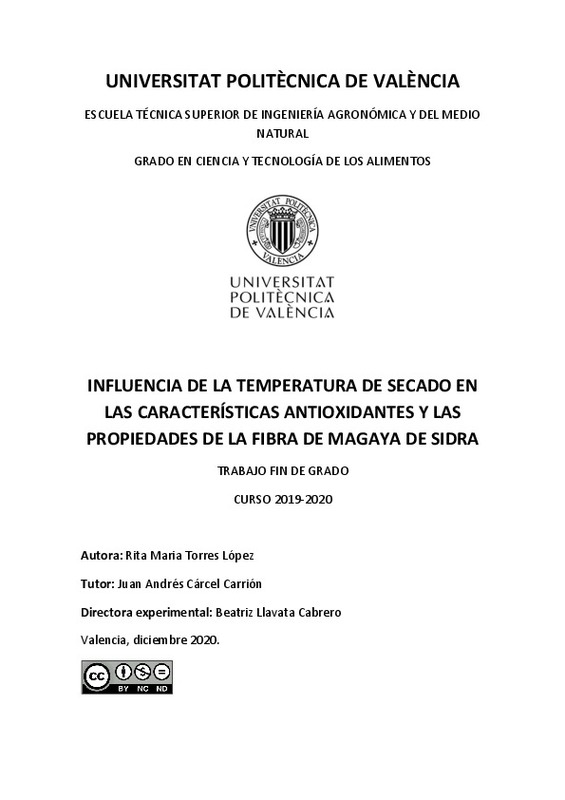|
Resumen:
|
[ES] La sidra se produce a partir de la fermentación del extracto obtenido a presión de diferentes variedades de manzana. El residuo sólido de dicho proceso se denomina magaya y actualmente no tiene un uso rentable. Sin ...[+]
[ES] La sidra se produce a partir de la fermentación del extracto obtenido a presión de diferentes variedades de manzana. El residuo sólido de dicho proceso se denomina magaya y actualmente no tiene un uso rentable. Sin embargo, este subproducto puede ser una fuente importante para la obtención de compuestos antioxidantes y/o compuestos bioactivos, como la fibra alimentaria. Para ello, y debido al elevado contenido en agua de este subproducto, se precisa de un tratamiento que permita conservarlo adecuadamente. El objetivo del presente trabajo es la determinación del impacto de la temperatura en la velocidad del secado de magaya y su influencia en las características antioxidantes y en la calidad de la fibra de ésta. Para ello, se realizaron experiencias de secado de magaya a 5 temperaturas diferentes (40, 60, 80, 100 y 120ºC). En el producto seco se determinó la capacidad antioxidante, el contenido en vitamina C y de compuestos fenólicos totales. Además, se evaluó su contenido en fibra a través de la determinación del residuo insoluble en alcohol y su caracterización a partir de la determinación de la capacidad de hinchamiento y la capacidad de retención de agua y de grasa. Las cinéticas de secado experimentales se ajustaron a un modelo difusivo que permitió cuantificar la influencia de la temperatura en el proceso. Por otro lado, se obtuvo que la temperatura más favorable para la retención de los compuestos fenólicos totales y vitamina C fue de 80ºC, mientras que la mejor conservación de la capacidad antioxidante se observó a 100ºC. Sin embargo, fueron las temperaturas más bajas ensayadas (40 y 60ºC) las que proporcionaron un residuo insoluble en alcohol con mayor retención de la capacidad de hinchamiento, de retención de grasa y de agua.
[-]
[EN] Cider is produced thanks to the fermentation of the extract, which is obtained under pressure, from different varieties of apples. The solid residue of this process is called magaya, which has not profit nowadays. ...[+]
[EN] Cider is produced thanks to the fermentation of the extract, which is obtained under pressure, from different varieties of apples. The solid residue of this process is called magaya, which has not profit nowadays. However, this by-product can be an important source for the obtainment of antioxidant and/or bioactive compounds, such as dietary fibre. For this purpose, and due to the high content of water that this by-product has, it is necessary to carry out a treatment in order to preserve it properly. The aim of the present study was to determine the impact of the temperature on the drying rate of the magaya and its influence on the antioxidant characteristics and the quality of its fibre. To this aim, magaya was dried at five different temperatures (40, 60, 80, 100 and 120ºC). The antioxidant capacity, the vitamin C content as well as the content of the total phenolic compounds were determined in the dry product. Moreover, its fibre content was evaluated by determining the alcohol-insoluble residue, and its characterisation was evaluated through the establishment of the swelling capacity and the water and fat retention capacity. The experimental drying kinetics were adjusted to a diffusive model that allowed to realise which was the temperature’s influence on this process. On the other hand, the study showed that the most favourable temperature for the retention of total phenolic compounds and vitamin C was 80ºC, while the best conservation of the antioxidant capacity was 100ºC. However, it was the lowest temperatures tested (40 and 60ºC) that provided an alcohol-insoluble residue with greater retention of the swelling capacity and the fat and water retention capacity.
[-]
|







